You'll love these budget-friendly DIY bird feeders that all cost under $10: classic peanut butter pinecones, recycled plastic bottle dispensers, paper tube seed rolls, upcycled jar feeders, clay dish platforms, suction cup window stations, and repurposed container trays. Most take less than 30 minutes to create using household items you already have. These simple projects attract diverse bird species while teaching children about nature and sustainability. Discover how these seven creative designs can transform your backyard into a birdwatching paradise.
Classic Pinecone Peanut Butter Feeders
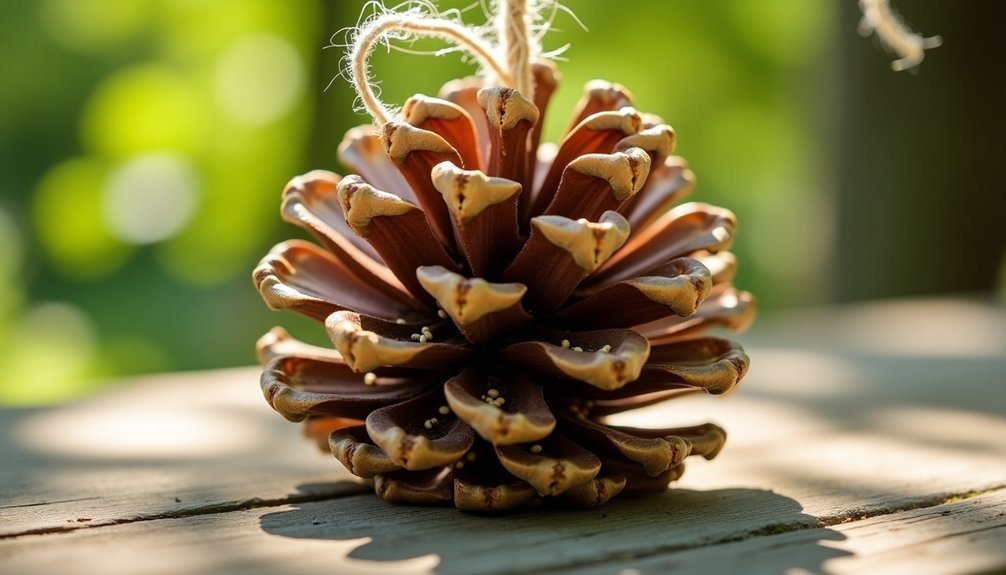
When looking for an affordable yet effective way to attract birds to your yard, the classic pinecone peanut butter feeder stands out as a timeless option.
You'll need just a few items: open pinecones, natural peanut butter, birdseed, and twine.
Start by tying twine around the top of your pinecone for hanging. Using a knife or popsicle stick, spread peanut butter generously between the scales.
Then roll the sticky pinecone in birdseed until thoroughly coated. This craft is suitable for everyone, from young children to seniors, making it perfect for family activities. For best results, choose a songbird mix with finer seeds that adhere better to the peanut butter.
Hang your creation where you can watch birds enjoy this protein-rich treat.
It's an eco-friendly project that costs under $10 and takes just minutes to complete.
Recycled Plastic Bottle Seed Dispensers
You'll appreciate how recycled bottle feeders deliver seed efficiently without waste falling to the ground.
These eco-friendly dispensers can be assembled in under 30 minutes using materials you already have at home. Creating these feeders requires just a plastic water bottle, string, simple tools, and birdseed for a complete project.
The strategic placement of feeding holes guarantees birds can access seeds while keeping the supply protected from rain and squirrels.
No-Waste Seed Delivery
Creating an efficient bird feeder doesn't require fancy materials or specialized tools. By strategically designing your plastic bottle feeder, you'll minimize seed waste while maximizing bird enjoyment.
Add drainage holes at the bottom to keep seeds dry and prevent mold growth. Position feeding holes at different levels to accommodate various bird species while maintaining proper seed distribution. The ideal hole size should allow easy access for birds without spilling excess seed—typically 1-2 inches in diameter works well. Make sure to create holes approximately 7 to 8 mm wide for optimal seed access while preventing excess spillage.
For enhanced efficiency, balance the weight distribution throughout your feeder to guarantee it remains stable when filled. Consider using two plastic bottles to increase capacity and stability.
Remember that different birds prefer specific seeds, so tailor your offerings accordingly. These simple adjustments will create a functional, eco-friendly feeder that reduces waste and supports local wildlife.
Quick Assembly Method
Turning your recyclables into functional bird feeders couldn't be simpler. Grab a clean plastic bottle, scissors, and some twine to create a feeder in under 10 minutes.
Start by cutting a 2-inch hole near the bottle's bottom, then insert a small stick or dowel rod beneath the opening as a perch.
Make several small drainage holes in the bottom to prevent seed spoilage. Thread twine through the bottle cap for hanging, then fill with your preferred birdseed.
For best results, hang your feeder from a tree branch that offers birds protection from predators while providing you with a good viewing angle.
This project is perfect for adding your personal touch since you can use outdoor paint to decorate your creation with vibrant colors or fun designs.
Position it near a water source if possible, and remember to clean your feeder every two weeks to prevent mold and disease spread among your feathered visitors.
Paper Tube Birdseed Rolls for Windowsills
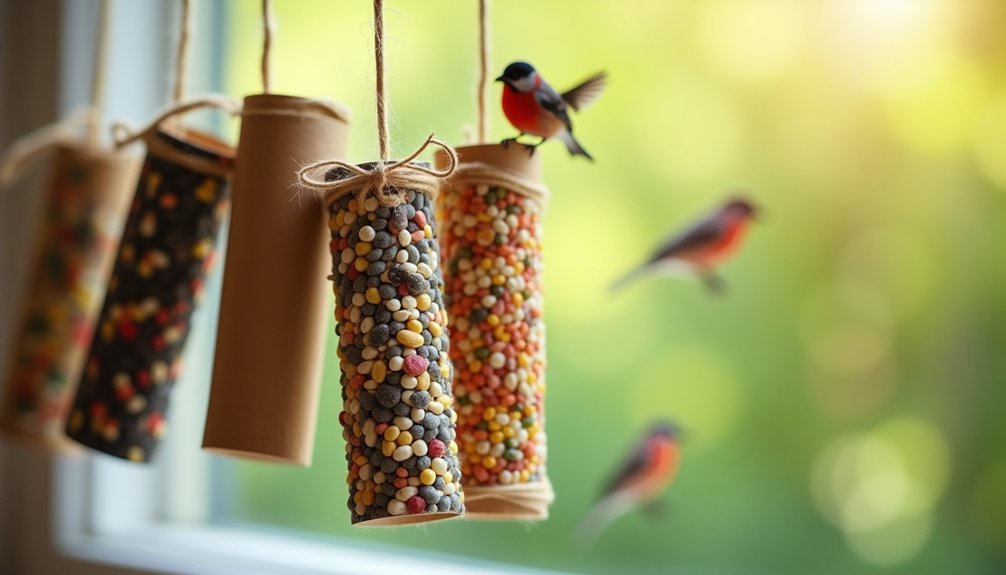
While many bird feeders require special equipment or carpentry skills, paper tube birdseed rolls offer a simple alternative that costs virtually nothing to make.
You'll only need cardboard tubes, a binding agent like peanut butter, birdseed, and string.
Creating these feeders is straightforward: coat your toilet paper roll with peanut butter, roll it in birdseed until thoroughly covered, thread string through for hanging, and position near a window.
For a nut-free version, substitute vegetable shortening or sunflower seed butter.
These eco-friendly feeders attract finches, chickadees, and sparrows while recycling household waste. This craft makes an excellent educational activity for children at home or in school settings.
They're especially valuable in winter when birds need extra calories.
Just avoid using honey as a binder, as it can harbor harmful bacteria.
Remember to check them regularly and replace when needed.
Upcycled Jar Gravity Feeders
Choose clear glass jars with wide mouths for your gravity feeder, allowing birds easier access to seeds while providing you with a better view of seed levels.
You'll need to create feeding holes about 1/2 inch from the bottom of the jar using a drill or nail, ensuring they're large enough for seeds to flow through but small enough to prevent overspilling.
Secure a sturdy wire or twine around the jar's neck to create a hanging loop, then fill with birdseed and hang in a sheltered spot where birds can perch comfortably. This eco-friendly approach promotes upcycling while engaging children in wildlife observation.
Jar Selection Tips
When creating upcycled jar gravity feeders, selecting the right container makes all the difference in attracting birds and ensuring your feeder's longevity. Mason jars are ideal due to their thick glass and weather resistance, though any sturdy glass container can work effectively.
Choose jars with wide openings for easy filling and cleaning—this is essential for maintaining hygiene. Consider the size based on your target bird species; standard quart-sized jars hold plenty of seed while remaining manageable. For a decorative touch, you can attach amber and green beads along the edges using epoxy.
| Jar Type | Best For | Size Matters | Maintenance Tip |
|---|---|---|---|
| Mason Jars | Durability | Medium-sized for most birds | Monthly cleaning |
| Vintage Jars | Aesthetic appeal | Varies with design | Check for cracks |
| Sauce Jars | Budget options | Smaller, suitable for finches | Easy to replace |
| Decorative Glass | Garden enhancement | Choose wider bases for stability | Weather-proof seals |
Simple Assembly Steps
Creating your own gravity feeder requires just five basic materials and minimal tools. Gather a jar, wooden dowel, wire, small nails or screws, and a hot glue gun. You'll also need basic tools like a drill, pliers, and screwdriver.
Begin by drilling holes in the jar's lid for seed dispensing. Insert the wooden dowel through these holes, securing it with hot glue. The dowel serves as both support and perch for feeding birds. Pre-drilling holes is recommended to prevent splitting when working with wood components.
Attach wire to the jar's neck for hanging, ensuring it's strong enough to support the filled feeder. Position the feeding tube at a slight angle to enhance gravity-activated food flow.
Make final adjustments to optimize seed dispensing rate and add any decorative touches you'd like. The entire project costs under $10 and can be completed in one afternoon.
Eco-Friendly Clay Dish Feeders
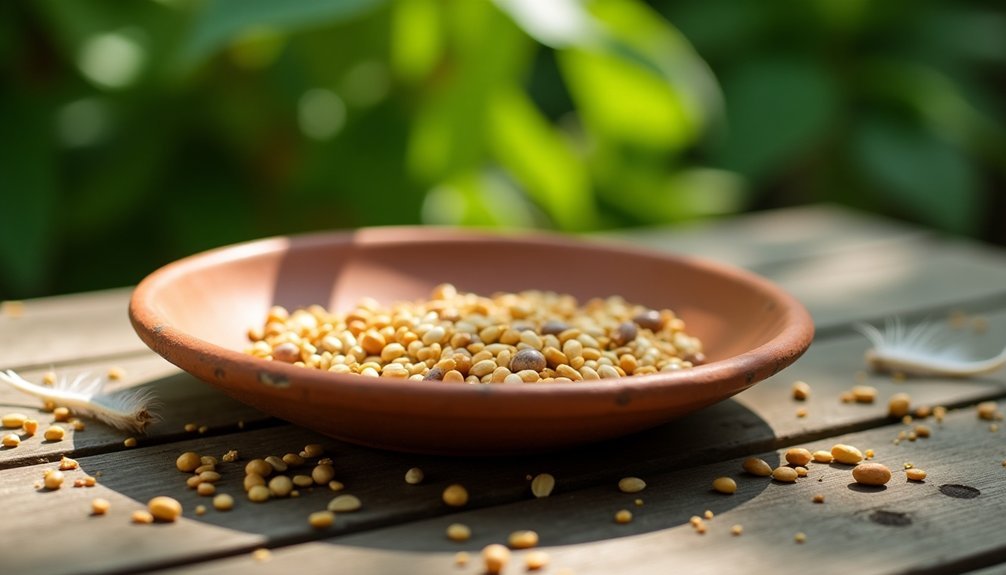
Terracotta and stoneware clay offer perfect foundations for creating beautiful bird feeders that won't break your budget.
These 100% natural materials maintain ideal moisture levels and keep seed cool during hot summer days—something birds truly appreciate.
You don't need advanced pottery skills to get started. Basic techniques like pinching and coiling work well, using simple household tools.
The clay's versatility allows you to design feeders for specific bird species while adding visual interest to your garden.
For the simplest version, transform a small clay saucer into a hanging feeder by drilling holes and adding twine.
If you've got access to a kiln, you can create more elaborate designs with drainage holes and textured perches.
Your birds will enjoy these safe, non-toxic feeding stations while you enjoy their eco-friendly benefits. Consider incorporating functional design elements like small overhangs to protect bird food from rain and snow.
Suction Cup Window Watching Stations
While clay feeders enhance your garden's natural beauty, window feeders bring the avian spectacle right to your doorstep.
You'll enjoy intimate views of birds feeding and interacting just inches away from your window, making these perfect for nature lovers of all ages.
Creating your own suction cup window feeder is surprisingly simple.
Transforming your window into a bustling bird café requires nothing more than a few suction cups and your creative spirit.
Clean your window thoroughly with non-soapy water before attaching suction cups. Use recycled containers like cake pans attached with wire, and don't forget to add protective perches and a small roof to shield seeds from rain. The ideal design includes a roof that overhangs by inch to provide additional protection from the elements.
- Connect with nature – Watch birds up close without disturbing their natural behaviors
- Educational opportunity – Help children identify different species and observe feeding habits
- Year-round enjoyment – Enjoy birdwatching in comfort regardless of weather conditions
Repurposed Container Tray Feeders
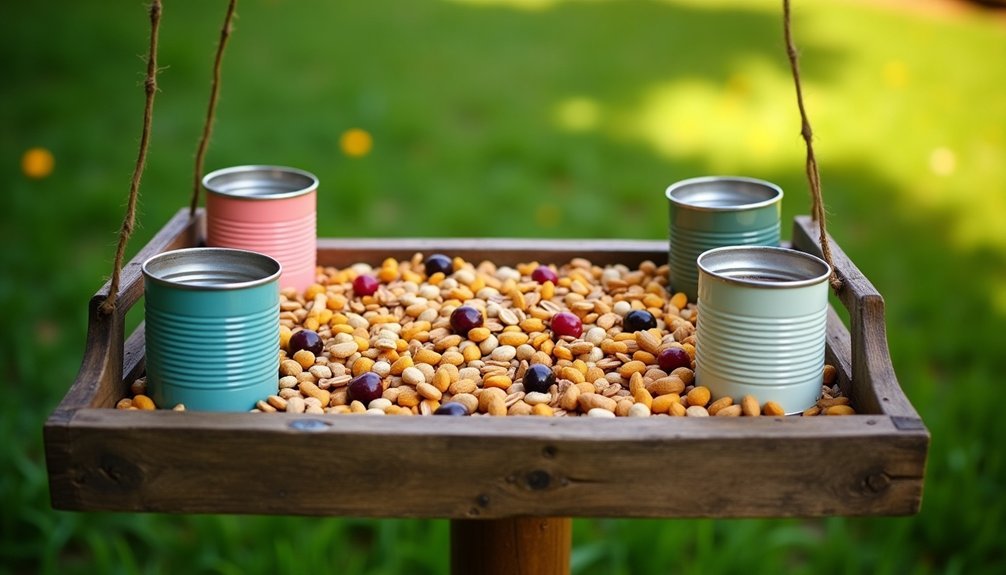
Transforming everyday household containers into charming bird feeders offers perhaps the most economical approach to bird watching. Plastic bottles, milk cartons, and takeout containers can all serve as perfect bases for your creation.
Before beginning, thoroughly clean your container. Cut feeding windows about 1-2 inches from the bottom, add perches using small sticks or dowels, and don't forget drainage holes to prevent mold. This type of project is perfectly suited for at-home engagement with children looking to learn about local wildlife.
Hang your feeder with twine or wire in a visible location. This eco-friendly project reduces waste while providing hours of entertainment. You'll need to refill regularly and clean your feeder every few weeks.
For added protection against squirrels, consider mounting techniques that limit access. The best part? You're not just feeding birds—you're teaching sustainability while enjoying nature without spending more than a few dollars.
Frequently Asked Questions
How Do I Prevent Squirrels From Raiding My DIY Bird Feeders?
To prevent squirrels from raiding your DIY bird feeders, use baffles, position feeders 5+ feet high and away from jumping points, add spicy repellents, or incorporate slippery surfaces. Distraction feeders with peanuts work well too.
Can These DIY Feeders Withstand Rainy or Snowy Weather?
Yes, your DIY feeders can withstand harsh weather if you add a roof, include drainage holes, use durable materials like PVC, and place them under natural cover. Regular maintenance will extend their lifespan.
Which Seed Types Attract the Widest Variety of Birds?
Black oil sunflower seeds attract the widest variety of birds. You'll see woodpeckers, nuthatches, chickadees, and cardinals at your feeder. Seed mixes in hopper feeders are also excellent for drawing diverse species.
How Often Should Homemade Bird Feeders Be Cleaned?
Clean your homemade bird feeders every two weeks for general health. If it's wet or hot outside, you'll need to clean them more often. This prevents disease and keeps birds healthy.
Are Certain DIY Feeder Materials Dangerous for Specific Bird Species?
Yes, certain DIY feeder materials can harm specific birds. You'll want to avoid plastic bottles for hummingbirds, pressure-treated wood for all species, and lead-containing materials that can poison birds through direct contact.
In Summary
You've now got 7 simple bird feeder options that won't break the bank. With basic household items and a few dollars' worth of seed, you'll attract a variety of feathered visitors to your yard or window. These DIY projects aren't just budget-friendly—they're also a fun way to reduce waste and connect with nature. Why not try making one this weekend?


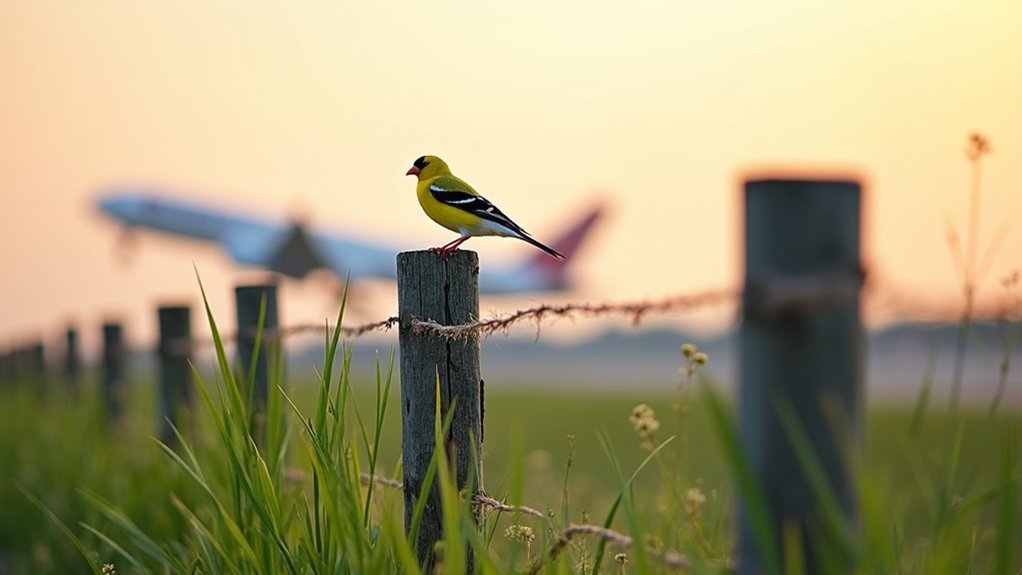
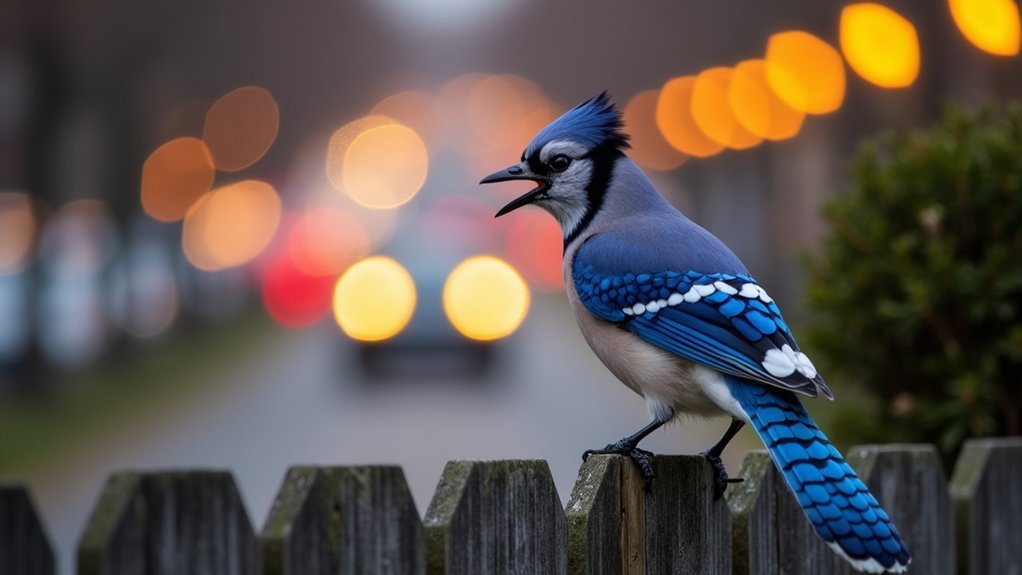
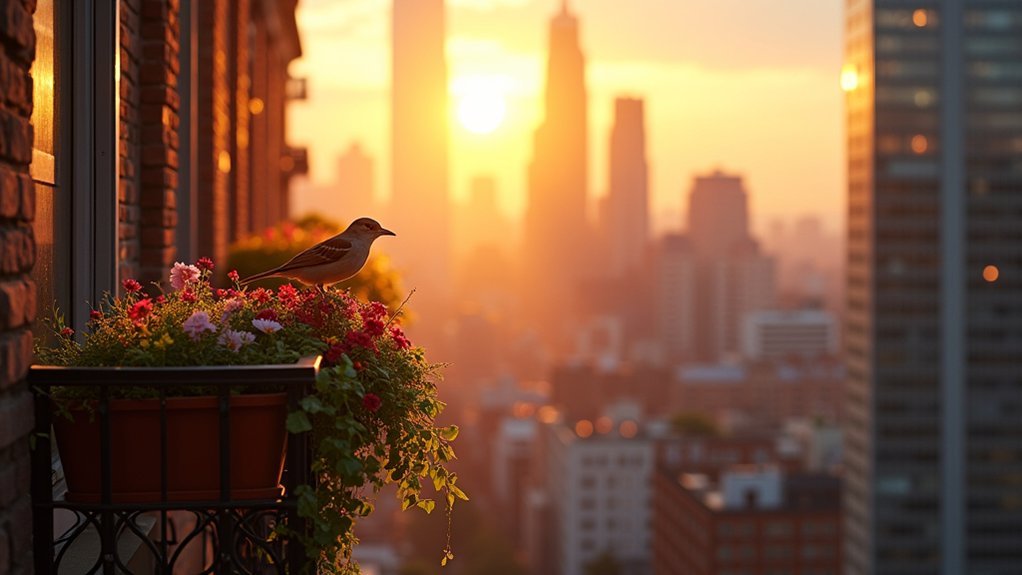
Leave a Reply